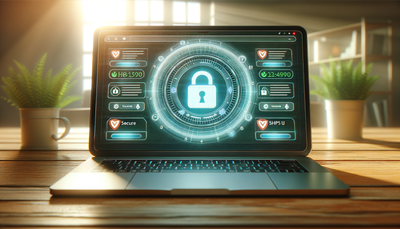How to Secure Your Domain Name and Prevent Hijacking
In today's digital landscape, your domain name is more than just an address—it's your online identity and a valuable asset. As cyber threats continue to evolve, it's crucial to implement robust security measures to protect your domain from hijacking attempts and unauthorized transfers. This article explores essential strategies to safeguard your domain name, including domain locking, two-factor authentication, and monitoring services. By following these best practices, you can significantly reduce the risk of domain theft and ensure the continuity of your online presence. Whether you're a small business owner or a large corporation, these security measures are vital for maintaining control over your digital assets and preserving your brand's integrity in the online world.Table of Contents:
-
Understanding Domain Hijacking
- Implement Domain Locking
- Enable Two-Factor Authentication
- Use a Robust and Unique Password
- Monitor Your Domain Regularly
- Keep Your Contact Information Up-to-Date
- Choose a Reputable Domain Registrar
- Educate Your Team on Domain Security
- Plan for Domain Renewal and Recovery
- Implement Domain Locking
- Enable Two-Factor Authentication
- Use a Robust and Unique Password
- Monitor Your Domain Regularly
- Keep Your Contact Information Up-to-Date
- Choose a Reputable Domain Registrar
- Educate Your Team on Domain Security
- Plan for Domain Renewal and Recovery

Understanding Domain Hijacking
Domain hijacking occurs when an unauthorized party gains control of a domain name without the rightful owner's consent. This can happen through various means, such as exploiting vulnerabilities in the domain registrar's system, social engineering attacks, or compromising the domain owner's account credentials. The consequences of domain hijacking can be severe, ranging from temporary loss of website access to permanent damage to brand reputation and financial losses. Hijackers may redirect traffic to malicious websites, intercept emails, or hold the domain for ransom. Understanding these risks is the first step in implementing effective security measures to protect your valuable digital asset. Do you need a website? Want to build a website but don't know where to start? Our website builder is the perfect solution. Easy to use, and with the ability to customize to fit your business needs, you can have a professional website in no time.
Implement Domain Locking
One of the most effective ways to prevent unauthorized transfers of your domain is to enable domain locking. This feature, also known as registrar lock or transfer lock, prevents any changes to your domain's registration information without your explicit authorization. When domain locking is active, attempts to transfer the domain to another registrar or modify crucial details will be automatically blocked. To implement domain locking:1. Log in to your domain registrar's control panel
2. Locate the domain security settings
3. Enable the domain lock or transfer lock option
4. Save your changes
Remember to keep the lock enabled at all times, only disabling it temporarily when you need to make legitimate changes to your domain's settings.
Enable Two-Factor Authentication
Two-factor authentication (2FA) adds an extra layer of security to your domain registrar account by requiring a second form of verification in addition to your password. This typically involves entering a unique code sent to your mobile device or generated by an authentication app. By enabling 2FA, you significantly reduce the risk of unauthorized access to your account, even if your password is compromised. To set up 2FA:1. Access your domain registrar's security settings
2. Look for the two-factor authentication option
3. Choose your preferred 2FA method (SMS, authenticator app, etc.)
4. Follow the setup instructions provided by your registrar
Once enabled, you'll need to provide the second factor each time you log in, making it much harder for potential hijackers to gain access to your account.
Building a website with SITE123 is easy
Use a Robust and Unique Password
While it may seem obvious, using a strong, unique password for your domain registrar account is crucial in preventing unauthorized access. Many domain hijacking attempts succeed due to weak or reused passwords. To create a robust password:1. Use a combination of uppercase and lowercase letters, numbers, and special characters
2. Make it at least 12 characters long
3. Avoid using personal information or common words
4. Consider using a password manager to generate and store complex passwords securely
Additionally, never use the same password across multiple accounts. If one account is compromised, having unique passwords ensures that your other accounts remain secure. Regularly updating your password, ideally every 3-6 months, adds an extra layer of protection against potential breaches.
Monitor Your Domain Regularly
Vigilant monitoring of your domain is essential in detecting and responding to potential security threats quickly. Many registrars offer domain monitoring services that alert you to any changes or attempted changes to your domain's settings. These services can notify you of:1. Unauthorized transfer attempts
2. Changes to DNS settings
3. Modifications to contact information
4. Expiration warnings
In addition to using your registrar's monitoring tools, consider setting up Google Alerts for your domain name. This will notify you if your domain appears in new web content, which could indicate unauthorized use. Regularly checking your domain's WHOIS information and DNS records can also help you spot any suspicious changes early on.
Keep Your Contact Information Up-to-Date
Maintaining accurate and current contact information for your domain registration is crucial for security and recovery purposes. Outdated contact details can lead to missed important notifications about your domain and complicate the process of regaining control if hijacking occurs. To keep your information current:1. Regularly review and update your domain's WHOIS information
2. Ensure that the email address associated with your domain is one you actively monitor
3. Consider using domain privacy services to protect your personal information from public view
4. If you change email addresses or phone numbers, update your domain registrar account immediately
Remember, your registrar may need to contact you urgently in case of suspicious activity, so having accurate information on file is essential for swift action and resolution.
Choose a Reputable Domain Registrar
Selecting a trustworthy and secure domain registrar is fundamental to protecting your domain name. A reputable registrar will offer robust security features, reliable customer support, and a track record of safeguarding their clients' domains. When choosing or evaluating your current registrar, consider the following:1. Security features offered (e.g., 2FA, domain locking, monitoring services)
2. Compliance with ICANN regulations
3. Customer support availability and responsiveness
4. User reviews and industry reputation
5. Transparency in pricing and renewal policies
While it's possible to transfer your domain to a new registrar, it's best to start with a reliable one to minimize the risk of security issues during the transfer process.
Educate Your Team on Domain Security
If multiple people in your organization have access to domain management, it's crucial to educate them about domain security best practices. This includes:1. Proper password hygiene
2. Recognizing phishing attempts
3. Understanding the importance of domain locking and 2FA
4. Knowing the proper procedures for making changes to domain settings
5. Being cautious about sharing account access or login information
Consider implementing a clear policy for domain management within your organization, detailing who has access, what level of access they have, and the procedures for requesting and implementing changes. Regular training sessions can help ensure that all team members are up-to-date on the latest security practices and threats.
Plan for Domain Renewal and Recovery
Allowing your domain to expire can create opportunities for hijackers to snatch it up. To prevent this:1. Set up auto-renewal for your domain
2. Keep your payment information up-to-date
3. Set reminders for manual renewal if auto-renewal isn't an option
4. Consider registering your domain for multiple years in advance
Additionally, have a domain recovery plan in place. This should include:
1. Detailed documentation of your domain ownership
2. Backup copies of your website and important files
3. Contact information for your registrar's support team
4. Understanding of the steps required to prove ownership and regain control
Being prepared can significantly reduce downtime and stress if you ever need to recover your domain.





